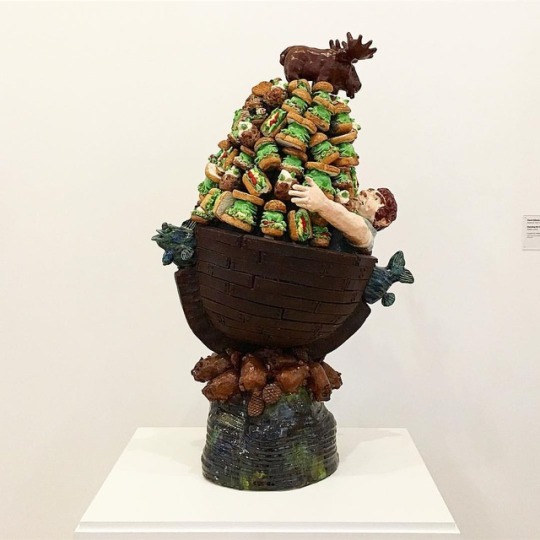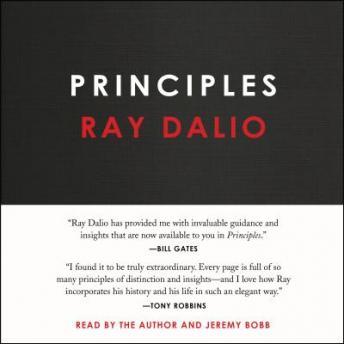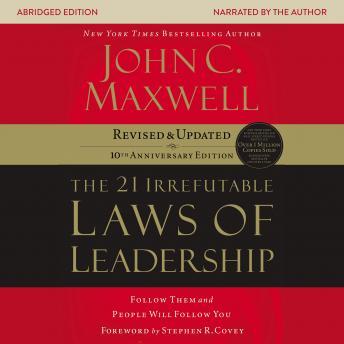#David Gilhooly
Explore tagged Tumblr posts
Text
For when you can't decide between #FishFriday and #FrogFriday:

David Gilhooly (American, 1943-2013) Merfrog and her Pet Fish, 1979 white earthenware & glazes, 7 x 6 x 7 3⁄8 in. (17.8 x 15.2 x 18.7 cm) Smithsonian American Art Museum & Renwick Gallery 2007.47.12
"David Gilhooly made his first ceramic frog during a friendly mug-making competition among classmates at the University of California–Davis. This inspired the artist to create a whole civilization composed entirely of frogs, ranging from Napoleon-inspired frog busts to frog-Egyptian gods. Gilhooly originally thought about making pigs, but decided not to, stating: "The trouble with making a PigWorld rather than the FrogWorld was that pigs are 'loaded.' That is, people have a lot of negative ideas that are attached to pigs...." In Merfrog and her Pet Fish, Gilhooly refers to one of his favorite themes, fertility, by creating an absurdly voluptuous frog surrounded by devoted singing companions." (Artist's website, www.davidgilhooly.com, January 2006)
#animals in art#20th century art#David Gilhooly#sculpture#frog#fish#Frog Friday#Fish Friday#American art#Smithsonian American Art Museum#fantastic creatures#frogworld#ceramics#pottery
23 notes
·
View notes
Text
Mastering The Art Of The Podcast Interview

How do you prepare for an interview? How do you prepare for your guest? How do you prepare your guest?
A few weeks ago, I published an article called The Ten Best Interviewers In Podcasting. Those top ten -- according to an impeachable source, me -- were:
Zale Mednick -- Preconceived
Jordan Harbinger -- The Jordan Harbinger Show
Matt Gilhooly -- The Life Shift Podcast
Evan Stern -- Vanishing Postcards
Mike Carruthers -- Something You Should Know
Robert Peterpaul -- The Art Of Kindness
Elaine Appleton Grant -- Sound Judgment
Audie Cornish -- The Assignment With Audie Cornish
David Pogue -- Unsung Science
Michael Barbaro -- The Daily
What makes an excellent podcast interviewer? What makes an excellent interviewer?
Is there a difference? In a word, yes.
TV show interviewers have video as their secret ingredient, since video images can communicate so much more than words. Podcasting video typically offers fans the host and guest with bulky headphones on and talking in a large mic on a swivel and surrounded by technology. It's not exactly visual stimulation overload.
Print interviews can be informationally dense but lacking in three-dimensional depth.
Podcast interviews are inherently sound-based, therefore tone of voice and voice cadence can be important clues to the listeners about the tenor of the interview. Sometimes, the silence can be as crucial and full of meaning as the words spoken.
Before we start, let's determine what makes a good podcast interviewer. I can write an entire article on these criteria, but for the sake of your time, let's summarize exceptional podcast interviewers via these traits.
Listens well. This is a contradiction because listening isn't asking questions, but a good listener assesses the direction of the interview, forms strong follow-up questions and truly engages with the subject.
Asks questions that spotlight the guest's expertise.
Keeps the interview focused on the guest, not the host.
Asks follow-up questions that result from the guest's previous comments.
Guides the guest through the interview by controlling the flow of information imparted by the guest. For example, less astute interviewers ask a question and then sit back while the guest blurts out all the information they have available before another question is asked.
So how do some of the best podcast interviewers handle an interview so artfully?
First question: How do you prepare for an interview?
Robert Peterpaul, host of The Art Of Kindness podcast, observes: "I need to get excited. If I'm excited about the guest, it propels me forward into all aspects of preparation. This is usually an easy task because every person has something unique to offer. On a practical note, my first step is always research. I get my hands (or ears) on as many interviews and resources about the guest as possible. While reviewing materials, I'm careful to flag what piques my interest. I jot down notes, questions, incoherent scribbles and then move on to the next. Then I comb through my notes and formulate interview questions based on the theme of my show. The order of questions is very important to me."
Peterpaul echoes a sentiment repeated by numerous podcast interviewers.
"It's also important that I don't over-research, so I can leave room for spontaneity. I want a balance of specific questions that show the guest I took time to prepare, but simultaneously allows us to go off the cuff."
Joe Casabona is a podcast systems coach who helps busy solopreneurs take back their time. Some even say he perfectly blends content creation and technology like it’s the best cup of coffee you’ve ever had (he says that).
Joe is also the host of the Podcast Workflows podcast.
Joe notes: "Do your research. Many podcasters will say they don’t do any research because they want to be surprised along with their audience. That’s lazy. The pilot of your airplane doesn’t say, 'I don’t like to know where we’re going until we’re in the air.' They know the exact flight path before takeoff. You can’t tell a story unless you know all the story beats first."
Joe offers an insight shared by many strong interviewers. "Do a pre-interview. This continues the research (finding things that may not be available online) as well as ensures you and your guest jive. There’s nothing worse than having a bad interview because you and your guest weren’t on the same page."
Finally, Joe offers sage advice about handling your guest. "Don’t tell your guest to come up with the topic/questions. You know your audience best. Don’t outsource this crucial part to someone who doesn’t know your audience at all."
Let's continue with our next question: How do you make sure the interview doesn’t go off track?
Robert Peterpaul of The Art Of Kindness has a unique take on this question.
"To some extent, I love going off track. Some of my favorite interview moments have been because I simply let the natural flow of conversation guide us. Of course, I never want to veer so far away that it's no longer interesting to the audience. I try to land somewhere in between an interview and a conversation… an inter-sation? I want the guest and I to have a fun banter, but if I see that we're losing time or getting too off topic, I'll swoop in with my next question. In many ways, the design of my questions helps with this. Laying down the questions, like stones in a path, allows me to ensure we get where we need to go. I would say you have to avoid the weeds that pop up between the path, but stepping onto the grass beside it isn't always a bad thing."
In an interview I did with Mike Carruthers, host of the Something You Should Know podcast, Carruthers discussed the interview process. "The toughest part of a podcast interview is keeping it interesting. I have a little voice in my head that keeps asking me right from the start of every interview, 'Is this really interesting,' or 'Is this going on too long,' or 'Is he/she really answering the question.'"
Carruthers continues: "I try to assume the mindset of the listener. And in my view, a listener wants every interview to get interesting – FAST. It would be easy to let people talk in the beginning about how they got interested in the topic or what is their background. But I don’t think that’s what an audience wants to hear first. They want to hear why this is interesting to them and why they should be listening. Then, once they care about someone, then they might be interested in their background."
Now, onto our final question. What is your process after the interview?
Carruthers from Something You Should Know advises: "That’s why I think editing is so important. I’ve done interviews where the first several minutes are edited out because the guest was just warming up. They didn’t get interesting until six or seven minutes into the interview. So in the show, that’s where the interview starts."
Carruthers then notes: "Other times I have had a guest say something really interesting two-thirds of the way through the interview. I will move that to the front of the segment to grab the audiences’ attention."
Carruthers also recommends a unique practice. "We ask all guests to watch a short video that tells people exactly what we expect from them."
Finally, Joe Casabona is blunt when he advises strongly that podcasters should "EDIT your interview."
Joe continues: "People don’t actually like raw, uncut interviews. Cut out the stuff that doesn’t make sense, the meandering bits, and the things that don’t contribute to the story."
There isn't any way to cover the complexities of conducting of a podcast interview that doesn't entail a book-length piece.
However, for those looking for more information on conducting a strong podcast interview, I recommend the upcoming December 14th episode of the Sound Judgment podcast with host Elaine Appleton Grant. In each episode, Grant and her guest -- a top audio creator -- deconstruct one of their episodes. It’s not just a revealing conversation about the art and craft of audio storytelling, but also about podcast interviewing.
I've found that the smartest people I've met ask a lot of questions. The people who think they are smart offer a lot of unsolicited answers.
Being an interviewer carries with it a lot of responsibility. As a podcast host, you are trying to transfer experiential and theoretical knowledge and accrued wisdom to an audience of listeners through a third person, the guest.
Basketball announcer Ernie Johnson once said, "A lot of times the interview relies not so much on the interviewee but on the interviewer."
0 notes
Photo

DAVID GILHOOLY (American, 1943-2013)
"Frog Franklin" , circa 1975-76
Glazed ceramic sculpture, 18" h. x 15" w. x 11" d.
#david gilhooly#ceramic sculpture#ceramicart#sculpture#fineart#frog#contemporarysculpture#collectart#buyart#artcollection#artcollector#artforsale
1 note
·
View note
Photo










David Gilhooly (April 15, 1943 - August 21, 2013) was an American ceramicist and printmaker. Gilhooly, together with Robert Arneson, Peter Vandenberge, Chris Unterseher and Margaret Dodd, working together in TB-9 (temporary building 9) were what was later to be called, The Funk Ceramic Movement of the San Francisco Bay Area.
Gilhooly states that his lowbrow humor makes his work accessible so that “even my most maiden old aunt or my most drugged-out cousin can get at the meaning of the work or at least experience it!”
2 notes
·
View notes
Photo


I'm so glad I saved this little ceramic roadkill frog from my mom's Goodwill pile years ago! He was made by artist David Gilhooly in 1982 ❤️🐸
9 notes
·
View notes
Text

David Gilhooly - Four Frog Tobiis Mugs, 1970
54 notes
·
View notes
Photo

Lumbership Sails into Dangerous Waters, David Gilhooly, 1981, Minneapolis Institute of Art: Decorative Arts, Textiles and Sculpture
boat in water, surrounded by beavers Lumbership Sails Into Dangerous Waters reflects the absolute absurdity and humor of the Funk movement. David Gilhooly was probably the most involved of Robert Arneson's students at Davis in the movement which rejected the elitism of art. Since the 1970s, the subject of frogs has consumed his work. He has developed extensive "frog worlds" which document the history, ethnology, religion, and myths of this frog civilization. His works both parody and demystify human civilization. In this work, it is the world of beavers that is spoofed as they prepare to devour the wooden ship. Size: 12-1/2 x 11-1/4 x 11-1/4 in. (31.8 x 28.6 x 28.6 cm) Medium: Glazed stoneware
https://collections.artsmia.org/art/6219/
13 notes
·
View notes
Photo

"Dagwood (Sandwich Multicouche)" de David Gilhooly en faïence blanche émaillée (2013) présenté à l'exposition “Les Flammes. L'Âge de la Céramique” au Musée d'Art Moderne de Paris (MAM), octobre 2021.
1 note
·
View note
Photo

Gilhooly's Breakfast Variety Pack, 1989, David James Gilhooly (at Bonham's)
15 notes
·
View notes
Photo

Ceramic sculptures from the Bay Area “Funk” movement are on view at the Anderson Collection at Stanford. David Gilhooly, Hoarding My Frog Food, 1982, glazed ceramics. #andersoncollection #robertarneson #richardshaw #davidgilhooly #funk #ceramic #sculpture #stanford @anderson.collection.stanford (at Anderson Collection at Stanford University)
1 note
·
View note
Text
Free Download Good to Great audiobook download Audio Book by Jim Collins
[Audio Books] Good to Great audiobook download by Jim Collins
Built To Last, the defining management study of the nineties, showed how great companies triumph over time and how long-term sustained performance can be engineered into the DNA of an enterprise from the very beginning.
But what about companies that are not born with great DNA? How can good companies, mediocre companies, even bad companies achieve enduring greatness? Are there those that convert long-term mediocrity or worse into long-term superiority? If so, what are the distinguishing characteristics that cause a company to go from good to great?
Over five years, Jim Collins and his research team have analyzed the histories of 28 companies, discovering why some companies make the leap and others don't. The findings include:
- Level 5 Leadership: A surprising style, required for greatness. - The Hedgehog Concept: Finding your three circles, to transcend the curse of competence. - A Culture of Discipline: The alchemy of great results. - Technology Accelerators: How good-to-great companies think differently about technology. - The Flywheel and the Doom Loop: Why those who do frequent restructuring fail to make the leap.

Download Good to Great audiobook download by (Jim Collins)
Duration: 9 hours, 59 minutes
Writer: Jim Collins
Publisher: HarperAudio
Narrators: Jim Collins
Genres: Jim Collins
Rating: 4.5
Narrator Rating: 4.43
Publication: Thursday, 01 July 2010

Good to Great audiobook download Reviews
Justin A
Good to Great is an excellent book, filled with fascinating insights for the business leader, or anyone striving to make their organization "Great". This book is a MUST READ before implementing the next big change or improvement program in your business, or hiring the next key-person. It is a must-read for anyone wanting to build a great company as well... Having the author narrate adds to the content & message of the book as well. Having Collins narrate allows him to place special emphasis on things particularly important to him, as well as offer his commentary & reflections, that most certainly would not exist if the publisher used a 3rd-party narrator. Also, in this audio version, Collins give his insight into the work several year after the book's publishing, which only reaffirms, or sheds new light, or clarifies certain points throughout the book. He even goes so far as to include several "Frequently Asked Questions" since the book's initial publishing, and offers his insight to these questions as well. I must also address some of the negative reviews about the book as well. Since publishing, some of the companies discussed in the book have fallen from their "Great" status, and several people have dismissed the book because of that. However, Collins addresses this very point in the epilogue of the book - at the time of it's initial writing - pointing out that "IF" a company were to lose it's "Great" status, it would not negate the findings of the research, and the book itself. Fixating on the long-term success after the "Good to Great" research totally misses the point - a point which Collins very clearly addresses near the end. In short, this is an absolute MUST READ for people wanting to initiate change in their business, or simply for those wandering "what makes some businesses great," or "can my business become great...?" Good to Great is an absolute must read - I cannot recommend it more highly.
Rating: 5
Dan Gilhooly
I would highly recommend this to anyone, great concepts and very insightful.
Rating: 5
Adam Horton
Really great read for anyone that works in any business. The negative reviews of this book are obvious people that haven't read or didn't listen to the author. The research and data is historical and just because you a company was great doesn't mean they always are and will be. Don't bash something if you don't actually read and listen to it.
Rating: 5
Ruben Banuelos
Chapters 5 and on just fly with enticing information! Couldn't stop listening to it at that point.
Rating: 5
Jessica Carper
Great listen! I am not a CEO or business owner, but will be able to find many uses for the shared insights of this book.
Rating: 5
John Van Iperen
Well researched and a great read. definitely learned a lot.
Rating: 5
Matt Singletary
It was an enjoyable and interesting book and seems to be a well-done study with principle findings that can be applied for successful living
Rating: 5
Dustin wallace
Very good book. Extremely inspirational if your open minded to a common sense approach to elevating the quality of your business
Rating: 5
Joe Gonzalez
The Best Book I ever read or listen to awesome book
Rating: 5
John Rebimbas
This is not a "good" book! It's a "GREAT" book. Simply Awesome ... Great job Jim!
Rating: 5
Related Audio Books
Extreme Ownership: How U.S. Navy SEALs Lead and Win

Original Author: Leif Babin,Jocko Willink
Sales Success Stories: 60 Stories from 20 Top 1% Sales Professionals

Original Author: David Weiss,Camille Clemons,Trong Nguyen,Trey Simonton,Phil Terrill,Paul Divincenzo,Mike Dudgeon,Kyle Gutzler,Kevin Walkup,Justin Bridgemohan,John Hinkson,Jelle Den Dunnen,Jacquelyn Nicholson,George Penyak,Florin Tatulea,Dejuan Brown,Debe Rapson,Dayna Leaman,Aj Brasel,Scott Ingram,Lee Bartlett
Measure What Matters: How Google, Bono, and the Gates Foundation Rock the World with OKRs

Original Author: John Doerr
Start with Why: How Great Leaders Inspire Everyone to Take Action

Original Author: Simon Sinek
TenX Rule: The Only Difference Between Success and Failure

Original Author: Grant Cardone
Emotional Intelligence 2.0

Original Author: Jean Greaves,Travis Bradberry
Unshakeable: Your Financial Freedom Playbook

Original Author: Peter Mallouk,Tony Robbins
Crushing It!: How Great Entrepreneurs Build Their Business and Influence-and How You Can, Too

Original Author: Gary Vaynerchuk
Leadershift: The 11 Essential Changes Every Leader Must Embrace

Original Author: John C. Maxwell
Find Your Why: A Practical Guide for Discovering Purpose for You and Your Team

Original Author: Peter Docker,David Mead,Simon Sinek
Dichotomy of Leadership: Balancing the Challenges of Extreme Ownership to Lead and Win

Original Author: Leif Babin,Jocko Willink
Trump: The Art of the Deal

Original Author: Donald J. Trump,Tony Schwartz
Rich Dad Poor Dad: What The Rich Teach Their Kids About Money - That the Poor and Middle Class Do Not!

Original Author: Robert T. Kiyosaki
Lean Startup: How Today's Entrepreneurs Use Continuous Innovation to Create Radically Successful Businesses

Original Author: Eric Ries
Dare to Lead: Brave Work. Tough Conversations. Whole Hearts.

Original Author: Brené Brown
New One Minute Manager

Original Author: Ken Blanchard,Spencer Johnson, M.D.
MONEY Master the Game: 7 Simple Steps to Financial Freedom

Original Author: Tony Robbins
Never Split the Difference: Negotiating As If Your Life Depended On It

Original Author: Chris Voss,Tahl Raz
Principles: Life and Work

Original Author: Ray Dalio
Outliers: The Story of Success

Original Author: Malcolm Gladwell
E-Myth Revisited: Why Most Small Businesses Don't Work and

Original Author: Michael E. Gerber
Power of Habit: Why We Do What We Do in Life and Business

Original Author: Charles Duhigg
Five Dysfunctions of a Team: A Leadership Fable

Original Author: Patrick Lencioni
Great by Choice: Uncertainty, Chaos, and Luck--Why Some Thrive Despite Them All

Original Author: Morten T. Hansen,Jim Collins
21 Irrefutable Laws of Leadership: Follow Them and People Will Follow You

Original Author: John C. Maxwell
0 notes




